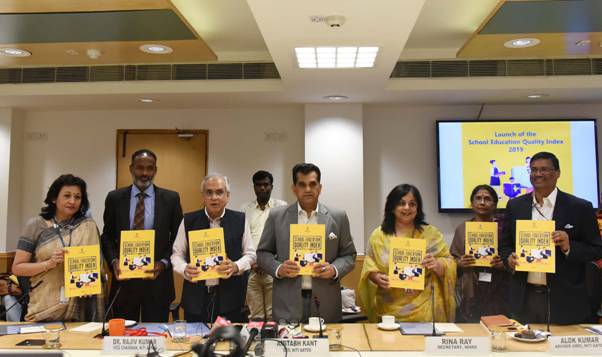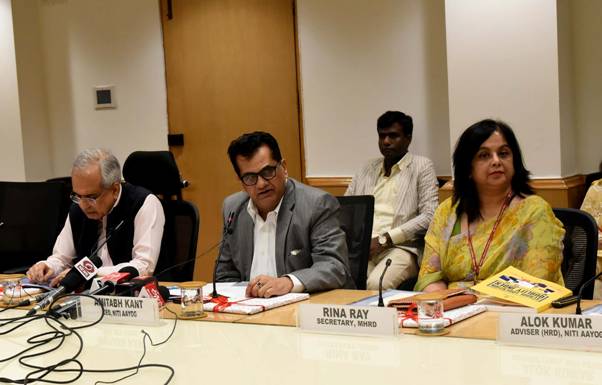NITI Aayog
NITI Aayog releases School Education Quality Index (SEQI)
Kerala, Manipur and Chandigarh top in overall performance
Haryana, Meghalaya, Daman & Diu show most improvement in the first edition of index.
प्रविष्टि तिथि:
30 SEP 2019 3:51PM by PIB Delhi
School Education Quality Index (SEQI) was developed by NITI Aayog to evaluate the performance of States and Union Territories (UTs) in the school education sector. The index aims to bring an ‘outcomes’ focus to education policy by providing States and UTs with a platform to identify their strengths and weaknesses and undertake requisite course corrections or policy interventions.

The first edition of SEQI was released today by Dr Rajiv Kumar, Vice-Chairman, NITI Aayog, in the presence of NITI Aayog Member Dr Vinod Paul, CEO Mr Amitabh Kant and Ms Rina Ray, Secretary, Department of School Education and Literacy, Ministry of Human Resource and Development and representatives from the World Bank.

In line with NITI Aayog’s mandate to foster the spirit of competitive and cooperative federalism, SEQI strives to facilitate the sharing of knowledge and best practices across States and UTs. Developed through a collaborative process, including key stakeholders such as Ministry of Human Resource and Development (MHRD), the World Bank and sector experts, the index consists of 30 critical indicators that assess the delivery of quality education. These indicators are categorized as below:
Category 1: Outcomes
-
- Domain 1: Learning outcomes
- Domain 2: Access outcomes
- Domain 3: Infrastructure and facilities for outcomes
- Domain 4: Equity outcomes
Category 2: Governance processes aiding outcomes
Schooling should result in successful learning outcomes. A credible system of assessment in this regard is crucial to design necessary remedial actions. To ensure the system is geared towards learning, SEQI assigns almost half its weight to learning outcomes. This sends a strong signal across the nation to ensure the focus remains centred on learning outcomes.
To facilitate a like-for-like comparison, States and UTs have been grouped as Large States, Small States and UTs. Within each of these groups, the indicator values have been appropriately scaled, normalized and weighted to generate an overall performance score and ranking for each State and UT.
States’ overall performance may hide variations in their performance on the underlying categories. Of the 20 Large States, 10 perform better on the Outcomes category, with the most noticeable performance differences observed in the cases of Karnataka, Jharkhand and Andhra Pradesh. The other Large States perform better on the Governance Processes Aiding Outcomes category, with the most noticeable performance differences observed in the cases of Odisha, Punjab and Haryana.
Of the eight Small States, seven perform better on the Outcomes category, with the most noticeable performance differences observed in the cases of Manipur, Tripura and Goa. Sikkim is the only Small State that performs better on the Governance Processes Aiding Outcomes category.
Of the seven UTs, four perform better on the Outcomes category, with the most noticeable performance differences observed in Dadra & Nagar Haveli. Delhi, Daman & Diu and Lakshadweep perform better on the Governance Processes Aiding Outcomes category
States’ and UTs’ performance on Learning Outcomes is driven by their results on the National Achievement Survey (NAS) 2017. Their performance on Access Outcomes is primarily driven by enrolment ratios at the secondary level and transition rates from upper-primary to secondary level. In terms of Infrastructure & Facilities for Outcomes, States’ and UTs’ performance is strongly linked to the presence of Computer Aided-Learning (CAL) at the elementary level and vocational education at the secondary and senior-secondary level.
Among the 20 Large States, 18 improved their overall performance between 2015-16 and 2016-17. The average improvement in these 18 states is 8.6 percentage points although there is a lot of variation around that average in terms of the fastest and slowest improving States. Due to this variation, many States that improved their overall performance score still show a decline in rank.
Five Small States have shown an improvement in their overall performance score between 2015-16 and 2016-17, with the average improvement being around nine percentage points. However, as in the case of Large States, there is considerable variation between the fastest and slowest improving States. States such as Meghalaya, Nagaland and Goa outpaced the others, improving by 14.1, 13.5 and 8.2 percentage points respectively, thus improving their ranks in the process.
All seven UTs have shown an improvement in their overall performance scores. The average improvement is 9.5 percentage points. Daman & Diu, Dadra & Nagar Haveli and Puducherry improved their overall performance scores by 16.5, 15.0 and 14.3 percentage points respectively, which enabled them to improve their ranking on incremental performance.
SEQI also included an analysis of States and Union Territories for each indicator under study. For instance, indicators such as average score in Class 3, 5 and 8 for Language and Mathematics, Transition Rates from primary to upper-primary level, capturing equity in learning outcomes between general and marginalised sections of society, supply a wealth of data for future action and policy design for every State.
States and UTs are ranked on their overall performance in the reference year 2016-17, as well as on their annual incremental performance (difference in the overall performance) between the reference year and base year (2015-16). The rankings present incredible insights on the status of school education across States/UTs and their relative progress over time.
A brief snapshot of the top and bottom performing States and Union Territories is as follows. The detailed report can be accessed at: http://social.niti.gov.in/
|
States/UTs
|
Overall Performance Ranking (2016-17)
|
|
Large States
|
- Kerala
- Rajasthan
- Karnataka
|
18. Punjab
19. Jammu & Kashmir
20. Uttar Pradesh
|
|
Small States
|
- Manipur
- Tripura
- Goa
|
6. Sikkim
7. Meghalaya
8. Arunachal Pradesh
|
|
Union Territories
|
- Chandigarh
- Dadra and Nagar Haveli
- Delhi
|
- Daman & Diu
- Andaman & Nicobar Islands
- Lakshadweep
|
| |
|
|
|
|
States/UTs
|
Annual Incremental Performance (Between Base Year: 2015-16 and Reference Year: 2016-17)
|
|
Large States
|
- Haryana
- Assam
- Uttar Pradesh
|
18. Jharkhand
19. Uttarakhand
20. Karnataka
|
|
Small States
|
- Meghalaya
- Nagaland
- Goa
|
- Sikkim
- Mizoram
- Arunachal Pradesh
|
|
Union Territories
|
- Daman & Diu
- Dadra and Nagar Haveli
- Puducherry
|
- Lakshadweep
- Chandigarh
- Andaman & Nicobar Islands
|
SEQI is envisioned as a dynamic instrument that will continue to evolve. Over time, the relevance of the existing indicators and the availability of data for new indicators will be factored into the index design. In particular, the linkages between policy actions and SEQI indicators will be analyzed to reflect the efforts made by States and UTs to improve school education.
Link to the report: https://niti.gov.in/content/school-education-quality-index
Link to Education Dashboard: http://social.niti.gov.in/edu-new-ranking
***
VRRK/AK
(रिलीज़ आईडी: 1586699)
आगंतुक पटल : 15358